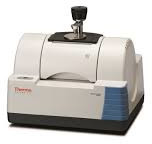This website uses cookies so that we can provide you with the best user experience possible. Cookie information is stored in your browser and performs functions such as recognising you when you return to our website and helping our team to understand which sections of the website you find most interesting and useful. More information in our Privacy Policy
Fourier Transform Infrared Spectrophotometer (FT-IR)
Supervisor : Paola Pinasco
Fourier transform infrared (FTIR) spectroscopy () provides structural information of the material, through the interaction of a radiation in the infrared region with the material itself. The interpretation of the obtained IR spectrum, allows:
– the identification of functional groups within molecules or structures and how they are linked to them
– recognition of the materials present, by comparison with databases
– evaluate the yield and the type of products formed at the end or during a reaction
It is a versatile technique for both organic and inorganic materials. It is mainly indicated for qualitative analysis. The instrument allows analyses in the range between the visible and the microwave region (11,000–3800 cm-1).
With this instrument it is possible to analyze liquid, solid bulk or powder samples, using the transmission or Total Attenuated Reflectance (ATR) technique. The latter allows to analyze the samples as they are, avoiding long preparation times and avoiding the major causes of error given by the poor reproducibility of the preparation methods and by the eventual hygroscopicity of the materials. This technique is used for analysis of the materials surface as well as for the characterization of materials with high thickness or highly absorbent that can be analyzed in transmission IR spectroscopy. The instrument is equipped with a diamond crystal to assure the best durability, chemical inertia and low background noise.
Technical characteristics of the instrument
ThermoFisher Nicolet IS5
Dynamic Bearing Air Bearing Interferometer
Permanently aligned pinned-in-place diamond-turned optics
Detector: High sensitivity DLA-TGS
Laser: Temperature-controlled near-IR solid-state laser diode

